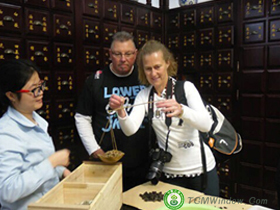
A couple from Switzerland shows great interest in steelyard that is still used in our pharmacy.
The steelyard is a Chinese invention. As early as 200 B.C., China began to make a scale of this type big enough to weigh several hundred pounds. The steelyard consisted of the following parts: an arm, a hook, lifting cords and a weigh. The arm or beam measured about 1.5 metres long, graduated with the weight units-jin and liang. The hook, hanging from one end of the arm, was used to lift up the object to be weighed. Hanging from the other part of the arm was the free-moving weight, attached on a looped string. On the arm was fixed one, two or three lifting cords, placed much closer to the hook than to the other end. Anything to be weighed should be picked up by the hook, whild the weigher lifted up the whole steelyard, holding one of the cords. He then slided the weight left or right until he found a perfect balance of the beam. He then read the weight from the graduation mark on which the weight-string rested.
This kind of steelyards is still in widespread use at market gatherings in China. They may be made in varying sizes working by the same principle, with the large ones to weigh foodgrain in bulk, pigs or sheep or their carcasses, and medium-sized ones for smaller transactions. There is also a miniature steelyard only about one third of a metre (about 1 foot) long, graduated with liang and qian. Used to weigh medicinal herbs and silver or gold, it first appeared about 1,000 years ago.
The steelyard is more convenient than the platform scale. Not only can it be carried around easily, but there is also no need for a whole set of weights. Corresponding to the lifting cords are different sets of graduation marks on the arm for different measuring ranges.
It is perhaps worthwhile to mention that the equal-armed platform scale appeared in China earlier than the steelyard with a sliding weight. A scale of the former description with a complete set of weights was discovered lately from a tomb near Changsha, Hunan Province, which dates back to the Period of the Warring States (475-221 B.C.). It is in size similar to those in use today and its component parts are found to be in good proportions.

![Diseases, Symptoms, tcm, [tcmwindow.com]](/uploadFile/adImg/2015/4/24/6de633b8-0a7a-4546-868a-02389edf5c65.png)





